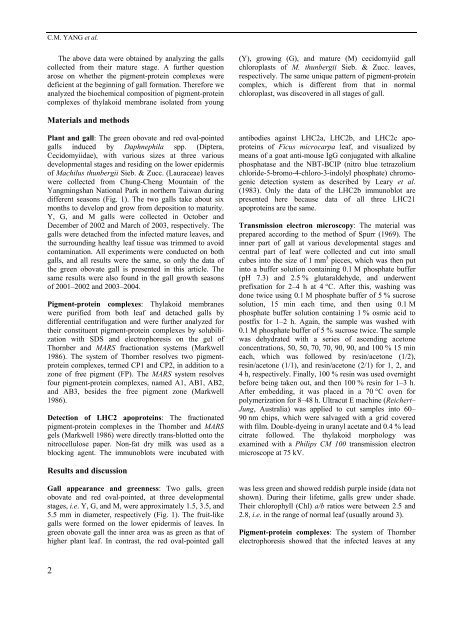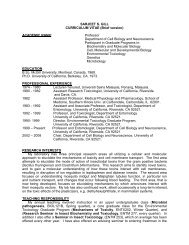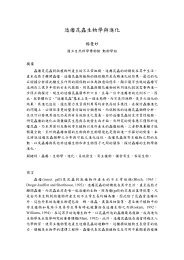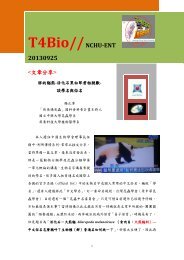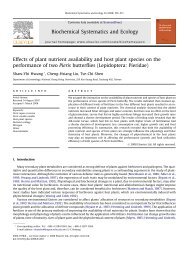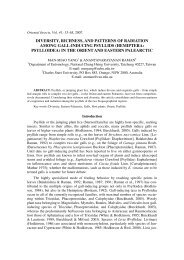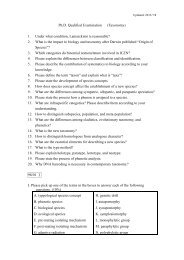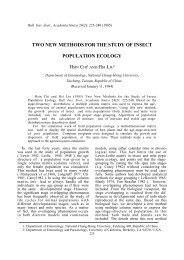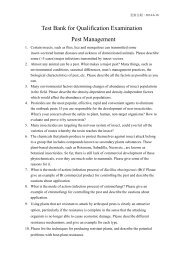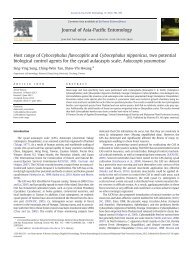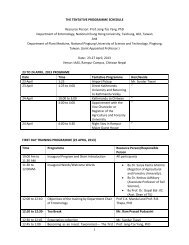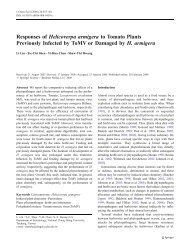Life time deficiency of photosynthetic pigment-protein complexes ...
Life time deficiency of photosynthetic pigment-protein complexes ...
Life time deficiency of photosynthetic pigment-protein complexes ...
You also want an ePaper? Increase the reach of your titles
YUMPU automatically turns print PDFs into web optimized ePapers that Google loves.
C.M. YANG et al.The above data were obtained by analyzing the gallscollected from their mature stage. A further questionarose on whether the <strong>pigment</strong>-<strong>protein</strong> <strong>complexes</strong> weredeficient at the beginning <strong>of</strong> gall formation. Therefore weanalyzed the biochemical composition <strong>of</strong> <strong>pigment</strong>-<strong>protein</strong><strong>complexes</strong> <strong>of</strong> thylakoid membrane isolated from young(Y), growing (G), and mature (M) cecidomyiid gallchloroplasts <strong>of</strong> M. thunbergii Sieb. & Zucc. leaves,respectively. The same unique pattern <strong>of</strong> <strong>pigment</strong>-<strong>protein</strong>complex, which is different from that in normalchloroplast, was discovered in all stages <strong>of</strong> gall.Materials and methodsPlant and gall: The green obovate and red oval-pointedgalls induced by Daphnephila spp. (Diptera,Cecidomyiidae), with various sizes at three variousdevelopmental stages and residing on the lower epidermis<strong>of</strong> Machilus thunbergii Sieb. & Zucc. (Lauraceae) leaveswere collected from Chung-Cheng Mountain <strong>of</strong> theYangmingshan National Park in northern Taiwan duringdifferent seasons (Fig. 1). The two galls take about sixmonths to develop and grow from deposition to maturity.Y, G, and M galls were collected in October andDecember <strong>of</strong> 2002 and March <strong>of</strong> 2003, respectively. Thegalls were detached from the infected mature leaves, andthe surrounding healthy leaf tissue was trimmed to avoidcontamination. All experiments were conducted on bothgalls, and all results were the same, so only the data <strong>of</strong>the green obovate gall is presented in this article. Thesame results were also found in the gall growth seasons<strong>of</strong> 2001–2002 and 2003–2004.Pigment-<strong>protein</strong> <strong>complexes</strong>: Thylakoid membraneswere purified from both leaf and detached galls bydifferential centrifugation and were further analyzed fortheir constituent <strong>pigment</strong>-<strong>protein</strong> <strong>complexes</strong> by solubilizationwith SDS and electrophoresis on the gel <strong>of</strong>Thornber and MARS fractionation systems (Markwell1986). The system <strong>of</strong> Thornber resolves two <strong>pigment</strong><strong>protein</strong><strong>complexes</strong>, termed CP1 and CP2, in addition to azone <strong>of</strong> free <strong>pigment</strong> (FP). The MARS system resolvesfour <strong>pigment</strong>-<strong>protein</strong> <strong>complexes</strong>, named A1, AB1, AB2,and AB3, besides the free <strong>pigment</strong> zone (Markwell1986).Detection <strong>of</strong> LHC2 apo<strong>protein</strong>s: The fractionated<strong>pigment</strong>-<strong>protein</strong> <strong>complexes</strong> in the Thornber and MARSgels (Markwell 1986) were directly trans-blotted onto thenitrocellulose paper. Non-fat dry milk was used as ablocking agent. The immunoblots were incubated withantibodies against LHC2a, LHC2b, and LHC2c apo<strong>protein</strong>s<strong>of</strong> Ficus microcarpa leaf, and visualized bymeans <strong>of</strong> a goat anti-mouse IgG conjugated with alkalinephosphatase and the NBT-BCIP (nitro blue tetrazoliumchloride-5-bromo-4-chloro-3-indolyl phosphate) chromogenicdetection system as described by Leary et al.(1983). Only the data <strong>of</strong> the LHC2b immunoblot arepresented here because data <strong>of</strong> all three LHC21apo<strong>protein</strong>s are the same.Transmission electron microscopy: The material wasprepared according to the method <strong>of</strong> Spurr (1969). Theinner part <strong>of</strong> gall at various developmental stages andcentral part <strong>of</strong> leaf were collected and cut into smallcubes into the size <strong>of</strong> 1 mm 3 pieces, which was then putinto a buffer solution containing 0.1 M phosphate buffer(pH 7.3) and 2.5 % glutaraldehyde, and underwentprefixation for 2–4 h at 4 °C. After this, washing wasdone twice using 0.1 M phosphate buffer <strong>of</strong> 5 % sucrosesolution, 15 min each <strong>time</strong>, and then using 0.1 Mphosphate buffer solution containing 1 % osmic acid topostfix for 1–2 h. Again, the sample was washed with0.1 M phosphate buffer <strong>of</strong> 5 % sucrose twice. The samplewas dehydrated with a series <strong>of</strong> ascending acetoneconcentrations, 50, 50, 70, 70, 90, 90, and 100 % 15 mineach, which was followed by resin/acetone (1/2),resin/acetone (1/1), and resin/acetone (2/1) for 1, 2, and4 h, respectively. Finally, 100 % resin was used overnightbefore being taken out, and then 100 % resin for 1–3 h.After embedding, it was placed in a 70 °C oven forpolymerization for 8–48 h. Ultracut E machine (Reichert–Jung, Australia) was applied to cut samples into 60–90 nm chips, which were salvaged with a grid coveredwith film. Double-dyeing in uranyl acetate and 0.4 % leadcitrate followed. The thylakoid morphology wasexamined with a Philips CM 100 transmission electronmicroscope at 75 kV.Results and discussionGall appearance and greenness: Two galls, greenobovate and red oval-pointed, at three developmentalstages, i.e. Y, G, and M, were approximately 1.5, 3.5, and5.5 mm in diameter, respectively (Fig. 1). The fruit-likegalls were formed on the lower epidermis <strong>of</strong> leaves. Ingreen obovate gall the inner area was as green as that <strong>of</strong>higher plant leaf. In contrast, the red oval-pointed gallwas less green and showed reddish purple inside (data notshown). During their life<strong>time</strong>, galls grew under shade.Their chlorophyll (Chl) a/b ratios were between 2.5 and2.8, i.e. in the range <strong>of</strong> normal leaf (usually around 3).Pigment-<strong>protein</strong> <strong>complexes</strong>: The system <strong>of</strong> Thornberelectrophoresis showed that the infected leaves at any2


